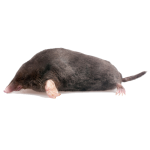Moles
Family: Talpidae

What are moles?
There are more than 30 mole species worldwide, and 7 of them are found in North America. If they didn’t tunnel, we would find them beneficial instead of annoying. Moles perform vital functions such as aerating soil and feeding on grubs, which are (to some) a dreaded lawn pest. Moles do not eat plant bulbs or plant roots as commonly perceived, but can be destructive in lawns, gardens, nurseries, parks, golf courses, and cemeteries. As moles burrow, mounds and ridges are produced and this can disfigure lawns, dislodge plants, and injure plant roots.
Around here, the eastern mole is the only mole species of concern. The following is a discussion based on the biology and habits of this species.
What is their biology?
Moles are physiologically built for digging underground. They have shovel-like front feet that are more broad than long. The backs of the feet face each other, have outward facing palms, and are equipped with heavy claws. To get through the soil, the mole uses a swimming motion. When soil is most adequate for tunneling, after a rain, they can travel up to 18 feet per hour.
Although equipped with good hearing, moles lack external ears to prevent interference when burrowing. Their eyes are covered with fused eyelids and can’t do more than distinguish between light and dark.
Moles mate during February and March and give birth to litters of 3 to 5 young after a 6-week gestation period. Young moles grow rapidly and attain the appearance and behavior of an adult by one month of age. Young moles may use their family’s burrow system for anywhere up to six months. After that, they begin branching off and establishing their own territory and burrows nearby.
What is their behavior like?
Moles are solitary animals. Except for the mating period, they attack each other upon meeting and will fight until one of the two retreats or is killed. Moles burrow and forage for food during both day and night.
Moles create two types of burrows– deep permanent burrows and shallow surface runways. Moist soil is almost always optimum for burrowing.
The commonly-seen raised tunnels that cause unsightly landscaping scenes are shallow surface runways. These tunnels can be used once, at irregular intervals, or on a regular basis. Surface tunnels connect to deeper tunnels located 3 to 12 inches below the surface.
The second type of tunnel, the deep tunnel, is the main mode of transport used by moles on a daily basis to travel to subsurface tunnels. The soil excavated through the production of these tunnels is deposited by the creation of short, vertical tunnels that result in volcano-like mounds. These volcano-shaped mounds are indicative of moles and should not be confused with horseshoe-shaped mounds that pocket gophers make.
The number of mounds occupying an area of land is not an accurate means of determining the number of moles in that area. A general rule of thumb when estimating mole population is that an acre of land can support 2 to 3 moles. However, areas that border large tracts of forested land or weedy fields are often subjected to increased mole population.
What do they eat?
As mentioned earlier, moles consume grubs, which destroy lawns by eating grass roots. This would make the mole a friend of the the landowner if they didn’t produce tunnels in the process.
In addition to eating grubs, moles enjoy earthworms, ants, centipedes, millipedes, and the occasional seed or vegetable matter. Moles possess an insatiable, voracious appetite and are able to satisfy their constant hunger without risking injury–their powerful forefeet provide excellent protection.
